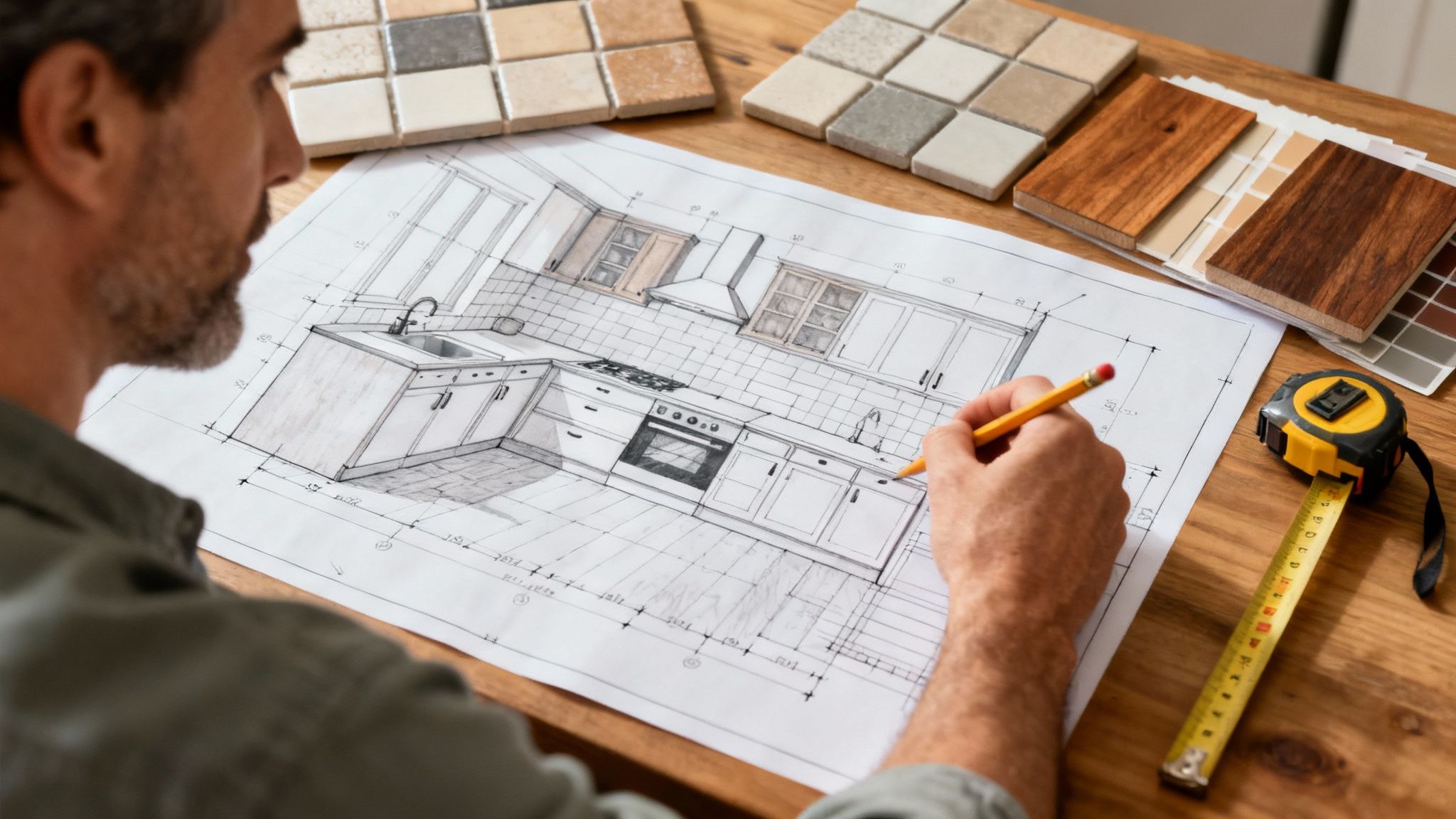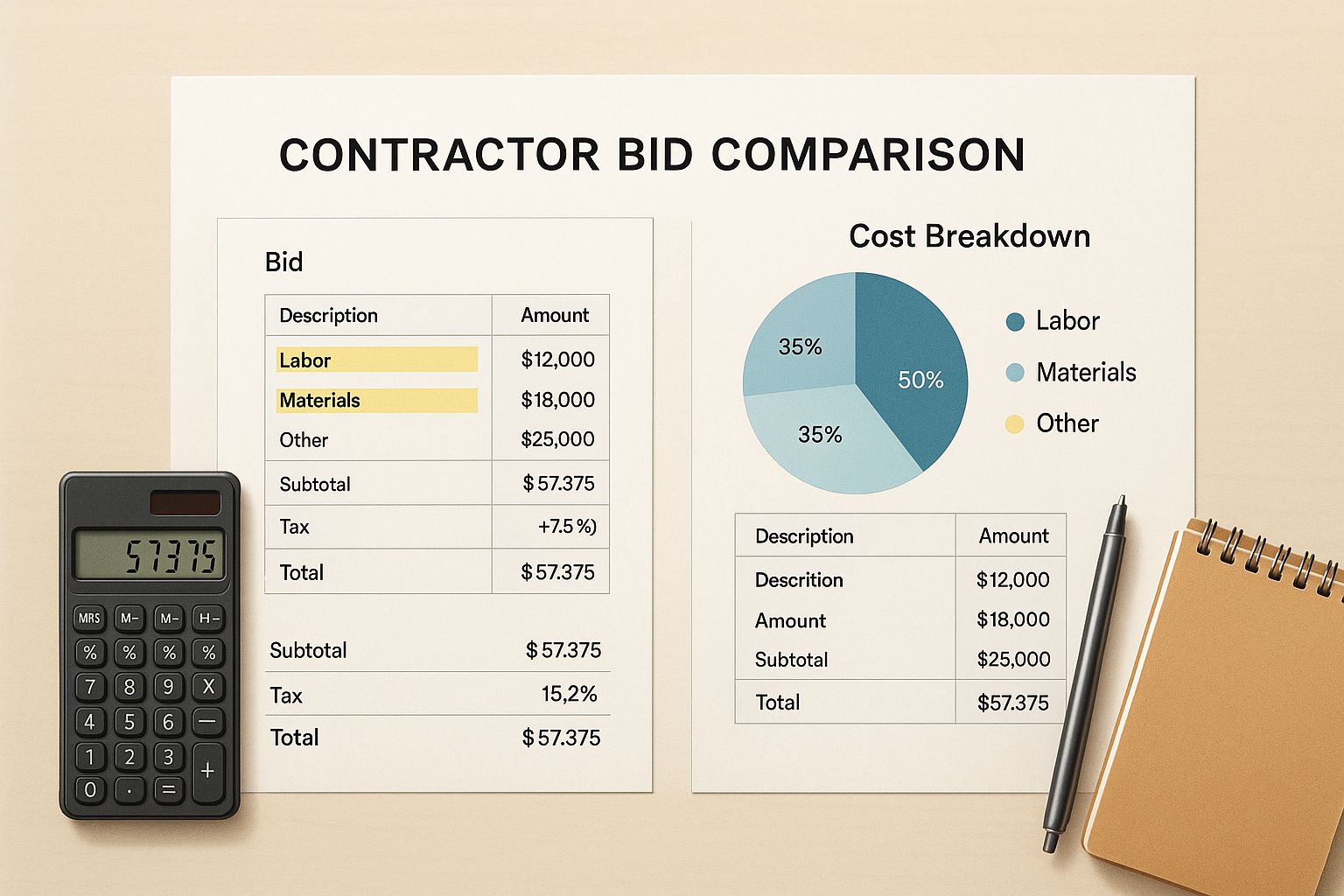How to Choose a General Contractor
Finding the right general contractor is a huge decision, but the real work starts long before you even think about making that first call. It all begins with you, a clear vision, and a solid plan. Turning those big ideas swirling in your head into a concrete, detailed roadmap is the single most important thing you can do to ensure your project runs smoothly and stays on budget.
First Things First: Get Your Project on Paper

Before you even start looking for a contractor, you need to know exactly what you want. Moving from a fuzzy concept like "a bigger kitchen" to a specific vision—complete with layouts, material choices, and must-have features—is absolutely essential. This isn't just busywork; this planning phase puts you firmly in the driver's seat.
Think of your project scope document as your build's constitution. It needs to spell out every last detail, leaving nothing to chance or assumption. This clarity is what allows contractors to give you accurate, apples-to-apples bids, saving you headaches down the road.
From Dream to Detailed Plan
Getting specific is the name of the game. "Update the master bath" is a wish. A plan sounds more like this: "Install a 60-inch floating double vanity with a marble top, replace the old tub with a walk-in shower tiled in white subway tile, and install a new, energy-efficient toilet."
See the difference? This level of detail ensures every contractor is bidding on the exact same project. It's your best defense against "scope creep"—that infamous problem where small changes and additions slowly blow up your budget and timeline. The bigger the project, the more critical these details become. If you're tackling a major build, it helps to understand the full journey, which you can explore in our guide to the custom home building process.
A detailed project plan isn't just for the contractor—it’s your number one tool for controlling your budget and guaranteeing quality. The more you sweat the details upfront, the less you'll sweat during construction.
Your Project Scope Checklist
To ensure nothing gets missed, a well-structured project scope document is your best friend. It acts as a single source of truth for you and any contractor you talk to.
Here’s a breakdown of what should be in that document.
| Project Goals & Vision | Sets the overall direction and helps the contractor understand your "why." | "Create an open-concept kitchen/living area for better family gatherings." |
| Detailed Work Description | Clearly defines what needs to be done, room by room. | "Demolish non-load-bearing wall. Install new flooring. Reroute plumbing for island sink." |
| Material & Finish Specs | Prevents assumptions and ensures quality and aesthetic consistency. | "Kitchen Cabinets: Shaker-style, painted Benjamin Moore 'Hale Navy'. Countertops: 3cm Calacatta Laza Quartz." |
| Drawings & Blueprints | Provides a visual guide for layouts, dimensions, and structural changes. | Architectural plans for a new addition, or even a detailed sketch of a bathroom layout. |
| Timeline Expectations | Establishes a desired start and completion date, managing expectations. | "Project to start no later than June 1st, with an ideal completion by September 15th." |
Having this level of detail organized before you solicit bids will make the entire process smoother and more predictable.
Building a Realistic Budget (With a Cushion)
A smart budget goes way beyond just the cost of lumber and labor. A truly realistic financial plan anticipates all the costs, not just the obvious ones. A good way to structure it is by breaking it down into three key parts:
- Hard Costs: This is the meat and potatoes of your budget. It covers all the labor, materials, and the contractor's fee for the physical construction.
- Soft Costs: These are the necessary but less tangible expenses, like fees for architects, engineers, and city permits. Plan for these to add another 10-15% to your total project cost.
- Contingency Fund: This is non-negotiable. Always set aside 15-20% of your total budget for the unexpected. Whether it’s finding rot behind a wall or deciding you really want those upgraded fixtures, this fund is your financial safety net.
Finding and Vetting Potential Contractors
Alright, with your detailed project plan in hand, it's time to find the right person to bring it to life. A quick Google search is one thing, but the best general contractors I’ve worked with almost always come from a trusted recommendation or a seriously thorough background check. Knowing how to find and properly vet your candidates is your single best defense against a project turning into a nightmare.
Start With People, Not Just Searches
Your first move should be to tap into your personal network. Talk to friends, family, and coworkers who have had similar work done recently. There's nothing more valuable than a firsthand account from someone you trust—they can give you the real story on a contractor's communication, reliability, and the quality of their finished work.
If your personal circle comes up empty, don't worry. Our guide on finding a home remodel contractor near me has some great strategies to get you started.
Another fantastic, often-overlooked resource? Your local building supply stores. The staff at the pro desk see contractors day in and day out. They know who's consistently busy, who pays their bills on time, and who has a reputation for doing things right. You can also check out professional organizations like the National Association of the Remodeling Industry (NARI), which maintains directories of members who have all committed to a strict code of ethics.
Doing Your Due Diligence
Once you have a shortlist of three to five contractors, the real work begins. Whatever you do, do not skip this step. Verifying a contractor’s credentials is the most important thing you can do to protect your investment and ensure your project is safe and up to code.
First, check their license. Every state has a licensing board, and most offer a simple online search tool. You can instantly see if their license is active and in good standing. More importantly, this search will show you if there are any formal complaints or disciplinary actions filed against them.
Next, confirm their insurance. This is non-negotiable. A legitimate contractor will carry two critical policies:
- General Liability Insurance: This covers your property if the contractor or their crew causes any damage during the project.
- Workers' Compensation Insurance: This is crucial. It covers any injuries that workers might sustain on your property, protecting you from being held personally liable.
Ask for a physical copy of their insurance certificates. Don't just take their word for it. Call the insurance provider listed on the certificate to confirm the policies are active and current. An uninsured contractor is a massive risk to your home and your finances.
Digging into Their Reputation and Team
Finally, take a look at their public reputation. Look up their business on the Better Business Bureau (BBB) to check their rating and see if any customer complaints have been filed. One bad review isn't always a dealbreaker—sometimes things just go wrong. But a pattern of unresolved issues? That’s a huge red flag.
It’s also smart to consider the stability of their team. The construction industry is facing some real labor challenges right now, with employment recently hitting 8.3 million, which ramps up competition for skilled tradespeople.
This is why you want a contractor with a stable, experienced team. A company that can't hold onto its people is more likely to face delays and quality control problems down the line. You can get more details on construction industry labor trends on deloitte.com. Taking the time to vet this carefully will help you narrow your list down to the most reliable pros for the job.
Getting Real About Bids and References
You’ve done the legwork and now have a few detailed bids in hand. This is where the real work begins. It’s so tempting to just scan for the lowest number at the bottom of the page, but I can tell you from experience, that's often a recipe for disaster. The cheapest bid is rarely the best value, and learning to spot the difference is crucial for a successful project.
A truly professional bid isn’t just a price tag; it's a roadmap. It should break down every part of the project—materials, labor, subcontractor costs, permits, you name it. This transparency is what lets you compare proposals fairly and see precisely what you're paying for.
The infographic below offers a great visual guide on how to break down different proposals to find the genuine value, not just the lowest price.

This side-by-side thinking is key. It forces you to look at the details behind the final number, which is where the most important information is hiding.
Digging Into the Bids
Start by spreading the bids out and looking at the major cost centers. For example, are the allowances for key materials in the same ballpark? If one contractor budgets $5,000 for your kitchen cabinets and another budgets $12,000, they’re not quoting the same project. That’s a massive quality difference you need to get to the bottom of.
Be wary of any bid that's dramatically lower than the others. An unusually low price is a giant red flag. It could signal a few things: they misunderstood your project scope, they're planning on using cheap materials, or worse, they're cutting corners on things you can't see, like proper insurance or skilled labor. If it feels too good to be true, it almost certainly is.
To really see what you're dealing with, a comparison table can be a huge help. It forces you to line up the details and see where the bids truly differ.
Comparing Contractor Bids Apples-to-Apples
| Material Allowances | $12,000 (Kitchen Cabinets) | $5,000 (Kitchen Cabinets) | Are the quality levels comparable? A lower allowance means lower-grade materials. |
| Labor Costs | Detailed by trade (e.g., plumber, electrician) | Single lump sum for "Labor" | Look for a transparent breakdown. A lump sum can hide inexperienced or underpaid workers. |
| Project Timeline | 8 weeks, with milestones | 5 weeks | Is the shorter timeline realistic or a sign of rushing? Ask for details on how they'll achieve it. |
| Change Order Process | Specified fee structure for changes | Vague mention of "additional costs" | A clear process protects you from surprise charges. Vague language is a warning sign. |
| Contingency Fund | 15% recommended in bid | Not mentioned | A contractor who plans for the unexpected is a contractor you can trust. No contingency is risky. |
By breaking it down like this, you're not just comparing prices; you're comparing the quality, professionalism, and foresight of each contractor. This is how you find the best partner, not just the lowest bidder.
The Make-or-Break Step: Checking References
Once you’ve analyzed the numbers and have a front-runner, it's time to check their references. Don't treat this like a formality. This is your single best opportunity to learn what it’s really like to have this person in your home or on your job site for weeks or months. Any contractor worth hiring will gladly provide a list of recent clients.
When you make those calls, have a list of smart questions ready. You need to go way beyond, "So, were you happy?" to get the truth.
A contractor’s past performance is the best predictor of your future experience. Don't just ask if they liked the final product; ask them about the journey to get there.
What to Ask Their Past Clients
Your mission is to understand how the contractor operates under pressure and when things inevitably don’t go according to plan.
Here’s what I recommend asking:
- Communication: How did they keep you in the loop? Were they easy to get ahold of when you had a question or concern?
- Budget: Did the final bill match the initial contract? If it didn't, were the changes discussed upfront and handled with professional change orders?
- Schedule: Did they stick to the timeline? If delays happened, did they explain why and manage expectations?
- Problem-Solving: What happened when something went wrong? How did they handle unexpected issues that popped up during the work?
Getting a feel for the market can also be valuable. With certain sectors like institutional facilities projected to grow, a contractor with a solid background in those areas often has better access to skilled labor and more stable footing. You can find some interesting data about 2025 construction market trends on skanska.com. The honest answers you get from these reference calls will give you the confidence you need to sign on the dotted line.
Sitting Down with Contractors to Find the Right Fit

You’ve done the legwork—vetted their credentials, compared the bids, and called their references. Now comes the most important part of the puzzle: the interview.
This face-to-face meeting isn't about numbers on a spreadsheet; it’s about people. This is your chance to really gauge their communication style, see their professionalism firsthand, and decide if this is a team you can trust in your home for the next several weeks or even months.
Think of it less like an interview and more like a partnership discussion. You’re looking for someone whose personality and process mesh with yours. Remember, you’re not just hiring a company logo; you’re hiring the person who runs the show.
Key Questions to Guide the Conversation
Don't just walk in and wing it. You need a plan to get past the bid details and understand how they actually work day-to-day. This isn’t about grilling them, but rather having a real conversation to see if you click.
Here are a few critical areas I always tell homeowners to dig into:
- Project Management: Ask them to walk you through a typical project from start to finish. How do they handle scheduling? Who is the main point of contact on-site every single day? Getting a clear picture of their workflow tells you exactly what to expect.
- Their Team and Subs: A contractor is only as good as the people they bring into your home. Ask about their core crew and the subcontractors they trust for plumbing, electrical, and other trades. A contractor who has worked with the same plumber for 10 years is a fantastic sign of stability and quality work.
- Communication Style: How often will you get updates? Will it be a daily text, a weekly email, or through a project management app? Nailing down these expectations now will save a ton of frustration down the road.
Trust your gut. Seriously. If a contractor is evasive, talks down to you, or makes you feel uncomfortable, that’s a massive red flag. Technical skill is non-negotiable, but a respectful working relationship is what makes a project go smoothly.
Understanding Their Process and People
Beyond their project management approach, you want to get a feel for the individuals who will be turning your vision into a reality. A well-organized team is a huge indicator of a well-run business. It's helpful to understand how a professional construction team is structured so you know who does what.
One of my favorite questions to ask is, "Tell me about a time a project went completely off the rails and how you fixed it." Their answer tells you everything you need to know about their problem-solving skills, honesty, and integrity.
Finally, bring up change orders. They happen in almost every project, but a pro knows how to manage them. A great contractor will have a crystal-clear, written process for any changes to the plan. This should detail how costs are calculated and how you approve everything before the work starts. That transparency is what protects your budget from getting out of control.
In the end, it's about balancing their qualifications, the bid, and your own comfort level. That’s how you’ll find the right person for the job.
It All Comes Down to the Contract
You’ve done the interviews, checked the references, and you have a winner. Fantastic. But before you break out the sledgehammer, there's one final, crucial piece of the puzzle: the contract. This isn't just a formality; it's the single most important document that will protect you, your home, and your wallet throughout this entire process.
Forget handshakes. A verbal agreement is worth about as much as the paper it’s not written on. A well-crafted contract is your project's blueprint for success, translating every conversation, plan, and expectation into a legally binding document. There should be absolutely no ambiguity.
My biggest piece of advice here? Never, ever sign a contract with blank lines or fuzzy descriptions like "install new flooring as discussed." Every single detail needs to be spelled out.
What a Rock-Solid Contract Looks Like
Think of your contract as the official rulebook for your renovation. It needs to be thorough, protecting both you and the contractor by setting clear expectations right from the start. Before your pen ever touches the paper, make sure these non-negotiables are included:
- A Hyper-Detailed Scope of Work: This is where you get granular. The contract should reference your initial plans and list every task, material, and even specific product model numbers. It's the difference between "install new kitchen faucet" and "Install a Delta Trinsic Single-Handle Pull-Down Sprayer Kitchen Faucet in Champagne Bronze (Model #9159-CZ-DST)." One is an instruction; the other is a contract.
- The Total Cost and a Milestone-Based Payment Schedule: The document must clearly state the total fixed price. Even more importantly, the payment schedule shouldn't be based on calendar dates. Tie every single payment to a tangible, completed milestone—think "payment due upon successful completion and inspection of drywall," not "payment due June 1st." A common, fair structure is 10% at signing, with the rest tied to progress.
A contractor demanding a massive upfront payment is one of the biggest red flags in the business. Anything over 30% is cause for serious concern. Reputable contractors have the credit and capital to get materials without needing a huge cash advance from you.
Don't Skip the Fine Print: Essential Legal Safeguards
Beyond the project specifics, your contract needs a few key legal clauses to protect you if things don't go according to plan. These aren't just suggestions; they are absolute must-haves.
Make sure your contract explicitly includes:
- Proof of Insurance: The agreement must state that the contractor holds both general liability and workers' compensation insurance. Don't just take their word for it—get the policy numbers in writing.
- Lien Waivers: This is your defense against a mechanic's lien. A lien waiver is a document signed by the contractor, subcontractors, and major suppliers acknowledging they've been paid for the work performed up to that point. You should get one of these with every check you write. It prevents a subcontractor you've never met from putting a lien on your house because your GC didn't pay them.
- A Formal Change Order Process: Renovations evolve. It happens. The contract needs to define exactly how changes are handled. A proper change order should be a written document outlining the new work, the additional cost, and any schedule adjustments. It must be signed by both you and the contractor before the new work starts.
- Dispute Resolution Clause: This section details how you'll handle disagreements. It often specifies mediation or arbitration as a first step, which can save everyone a ton of time, money, and heartache compared to jumping straight into a lawsuit.
Taking the time to get the contract right isn't just busywork. It's the final, and most critical, step in setting your project up for a successful, stress-free completion.
Your Top Contractor Questions, Answered
When you're gearing up to hire a contractor, a few key questions almost always come up. It's completely normal. Getting these sorted out early on helps you move forward with confidence and avoid common pitfalls. Let’s walk through some of the most frequent things homeowners ask.
How Many Bids Should I Really Get?
You might think casting a wide net is the best strategy, but collecting a dozen bids often just leads to confusion. I've seen homeowners get completely overwhelmed by too much information.
The sweet spot? Aim for at least three detailed bids from contractors you've already vetted. This gives you a solid benchmark for what your project should cost without drowning you in paperwork.
Fewer than three, and you won't get a real feel for the market. More than five, and you’ll find it nearly impossible to do a meaningful comparison of all the little details. The real key here isn't the number, but the quality. Make sure every single contractor is bidding on the exact same set of plans and specifications. That's the only way you can make a true apples-to-apples comparison.
What’s the Difference Between an Estimate and a Bid?
This one trips up a lot of people, and the difference is huge. Think of an estimate as a quick, back-of-the-napkin calculation. It’s a rough guess a contractor might give you early on, based on limited info, just to see if you're in the same ballpark. It’s not a number you can take to the bank.
A bid (or a proposal) is a completely different animal. It's a formal, legally binding offer to do a specific job for a specific price. To create a bid, a contractor has to dig deep into your project plans, figure out material costs, and calculate labor. You should only ever base your hiring decision on a detailed, written bid.
Never, ever sign a contract based on a simple one-page estimate. A real bid will break down the costs, list out material allowances, and clearly define the scope of work. It’s your best protection against unexpected costs down the road.
Is It Normal to Pay a Big Deposit Upfront?
A contractor will almost always ask for a down payment, and that's standard practice. They need it to order initial materials and officially book your project into their schedule.
However, you need to be wary of anyone asking for a huge chunk of cash right out of the gate. A reasonable down payment is typically between 10% and 30% of the total project cost. If someone asks for 50% or more, that’s a massive red flag. It could mean they have cash flow problems or are just not trustworthy.
The contract is your best friend here. It should spell out the entire payment schedule, linking every single payment to a tangible milestone. For example, a payment is due when the "foundation is complete," or after "drywall is installed." Payments should never be tied to calendar dates. This way, you're only paying for work you can see has actually been done.
At Northpoint Construction, we believe in transparency and partnership from the very first conversation. Whether you're planning a major remodel or a custom home build, our team is ready to turn your vision into a beautiful reality. Learn more about our services at buildnp.com.

